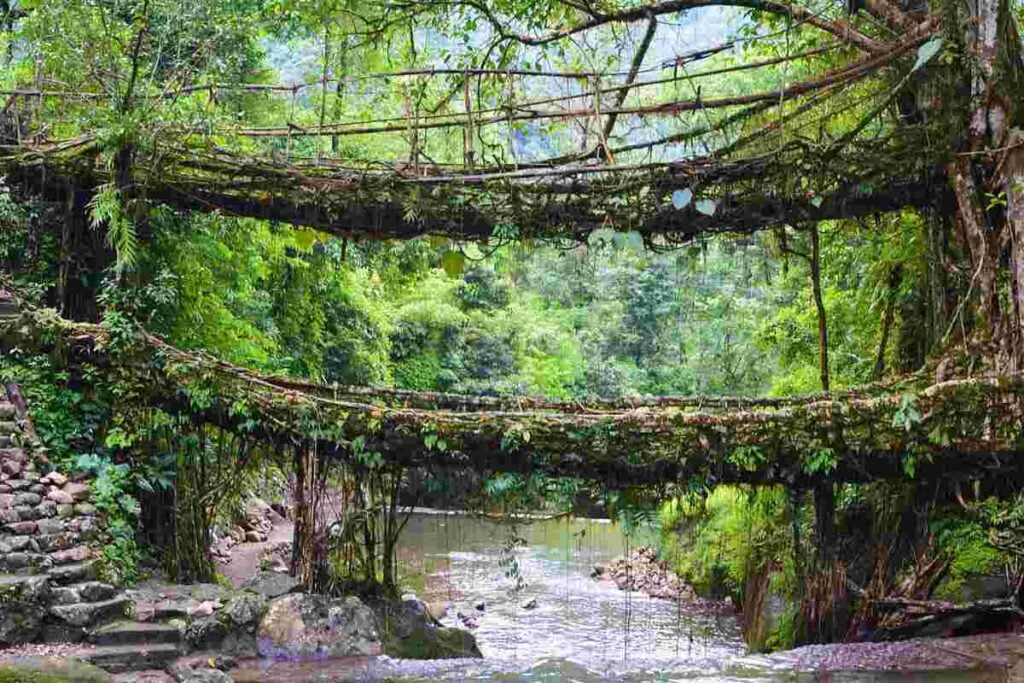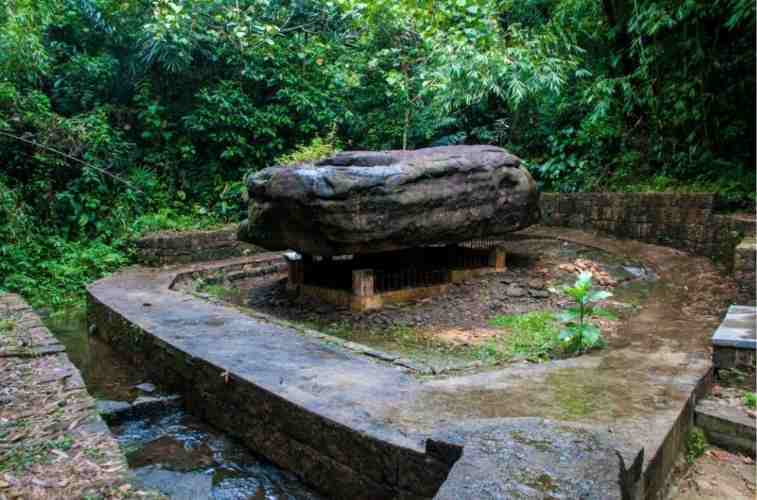
The enchanting state of Meghalaya is home to a remarkable natural marvel – Double decker living root bridges Meghalaya. These living structures, intertwined with the lush greenery of the region, are not only breathtaking to behold but also showcase the incredible ingenuity of indigenous communities. Let’s delve into the world of living root bridges Meghalaya and uncover their wonders.
Table of Contents
How to reach Double decker living root bridges Meghalaya From Shillong & Guwahati

From shillong to Double decker living root bridges Meghalaya:
By Road:
1. Private Vehicle: Take a private car or hire a taxi from Shillong to Cherrapunji, which is approximately 53 kilometers away.
2. Public Transport: Board a bus or shared taxi from Shillong to Cherrapunji.
Trekking Route:
1. Cherrapunji to Tyrna: From Cherrapunji, travel to Tyrna village, which is around 12 kilometers away. This journey can be covered by hiring a local taxi or trekking.
2. Tyrna to Double Decker Living Root Bridge: Embark on a trek from Tyrna village to the double-decker living root bridge in Nongriat village. The trek takes approximately 2-3 hours and covers a distance of about 3 kilometers.
From Guwahati to Double decker living root bridges Meghalaya:
By Road:
Private Vehicle: Drive from Guwahati to Cherrapunji, which is approximately 147 kilometers away. The journey takes around 4-5 hours by car.
Public Transport: Board a bus or shared taxi from Guwahati to Cherrapunji.
Trekking Route:
Cherrapunji to Tyrna: Upon reaching Cherrapunji, proceed to Tyrna village by hiring a local taxi or trekking.
Tyrna to Double Decker Living Root Bridge: Trek from Tyrna village to Nongriat village, where the double-decker living root bridge is located. The trek takes about 2-3 hours and covers a distance of approximately 3 kilometers.
Both routes offer scenic views of the picturesque landscapes of Meghalaya, making the journey to the double-decker living root bridge a memorable experience.
History of Double decker living root bridges Meghalaya
NONGRIAT ROOT BRIDGES Meghalaya, the history of living root bridges traces back to ancient times, entwined with the rich cultural tapestry of the indigenous communities. These remarkable structures, crafted from the living roots of Ficus elastica trees, stand as a testament to human ingenuity and symbiosis with nature.
- The tradition of building living root bridges dates back centuries, with oral histories passed down through generations. Legend has it that the practice originated from the need to navigate the rugged terrain of the region, where conventional bridges would often succumb to the harsh monsoon rains and swiftly flowing rivers.
- Over time, local communities honed their skills in coaxing the roots of the rubber trees to grow in a desired direction, guiding them across streams and rivers. Through a meticulous process spanning decades, the roots gradually intertwine and strengthen, forming robust bridges capable of supporting human traffic.
- These living structures not only serve as vital links between communities but also embody the spirit of resilience and cooperation ingrained in the cultural fabric of Meghalaya. They stand as living monuments to the ingenious techniques passed down through generations, showcasing the harmonious relationship between humans and the natural world.
- As time marches on, the legacy of living root bridges continues to inspire awe and admiration, drawing visitors from far and wide to witness their timeless beauty. They remain an integral part of the cultural heritage of Meghalaya, a testament to the enduring traditions and unwavering spirit of its people.
Read: Top Attraction in Meghalaya

Best time to visit Double decker living root bridges Meghalaya
The best time to visit the double-decker living root bridge in Meghalaya is during the dry season, which typically spans from November to April. During this time, the weather is pleasant, and the chances of heavy rainfall, which can make trekking to the bridge more challenging, are reduced. Additionally, the surrounding foliage is lush and vibrant, enhancing the overall experience of visiting this iconic natural wonder. It’s advisable to check local weather forecasts and trail conditions before planning your visit to ensure a smooth and enjoyable experience.
Trekking Step : The trek to bridge is almost 3km long and 3500+ steps.it takes an average of 2 h 20 min to complete. It takes whole day, but worth seeing once.
Location: Nongriat Meghalaya
Best time to visit : October to March

Living root bridge Cherrapunji
Nestled amidst the verdant landscapes of Cherrapunji, the living root bridge stands as a captivating marvel of nature’s ingenuity. Crafted over centuries by the skilled hands of indigenous communities, this natural wonder is a testament to human symbiosis with the environment. It take 30 minutes to reach living root bridge from cherrapunji to cover a distance of 20 km.
Formation and Construction:
The Double decker living root bridges in Cherrapunji is formed from the roots of the Ficus elastica tree, locally known as the rubber tree.
Indigenous Khasi and Jaintia tribes have carefully nurtured and guided the roots over streams and rivers, allowing them to intertwine and form sturdy bridges.
Location:
The living root bridge in Cherrapunji is located in the village of Nongriat, nestled within the lush greenery of the Meghalayan hills.
Accessible via a trek from nearby villages, the bridge offers a serene retreat amidst nature’s bounty.
Structural Features:
The bridge boasts a unique architecture, with its roots forming a lattice-like structure that is both resilient and flexible.
Over time, the roots grow stronger, creating a bridge capable of supporting the weight of humans and livestock.
Ecological Importance:
Beyond its structural beauty, the living root bridge plays a vital role in the local ecosystem.
The intertwined roots help prevent soil erosion and promote biodiversity, providing a habitat for diverse flora and fauna.
Single-Decker Living Root Bridge in Shillong
Nestled amidst the lush greenery of Shillong, the single-decker living root bridge stands as a testament to the extraordinary craftsmanship of nature and the indigenous communities of Meghalaya. This remarkable natural wonder, crafted over centuries, is a sight to behold for visitors seeking to explore the unique landscapes of the region.

Formation and Construction:
The single-decker living root bridge in Shillong is formed from the roots of the Ficus elastica tree, commonly known as the rubber tree.
Indigenous Khasi and Jaintia tribes meticulously guide the roots over streams and rivers, allowing them to intertwine and form a sturdy bridge.
Location:
The single-decker living root bridge in Shillong is located in the picturesque village of Mawlynnong, often referred to as the “cleanest village in Asia.”
Accessible via a short trek through verdant forests, the bridge offers a tranquil retreat amidst the natural beauty of Meghalaya.
Structural Features:
The bridge boasts a unique single-deck structure, with its roots forming a lattice-like pattern that is both resilient and durable.
Over time, the roots grow stronger, creating a bridge capable of supporting the weight of pedestrians and small livestock.
Ecological Importance:
Beyond its structural beauty, the single-decker living root bridge plays a crucial role in the local ecosystem.
The intertwined roots help prevent soil erosion and promote biodiversity, providing a habitat for diverse flora and fauna.
Cultural Significance:
The single-decker living root bridge holds deep cultural significance for the indigenous communities of Meghalaya.
It is revered as a symbol of communal cooperation and environmental stewardship, embodying the rich heritage of the Khasi and Jaintia tribes.
Visitor Experience:
Visitors to the single-decker living root bridge in Shillong are treated to a serene trek through lush forests and scenic landscapes.
The bridge offers a tranquil spot for relaxation and contemplation, surrounded by the sights and sounds of nature
Conclusion
In conclusion, the living root bridges of Meghalaya stand as remarkable testaments to the enduring ingenuity of indigenous communities and the harmonious relationship between humans and nature. These natural wonders, crafted over centuries with meticulous care and craftsmanship, are more than mere bridges—they are symbols of resilience, cultural heritage, and environmental stewardship.
As visitors marvel at the intricate lattice of roots forming these bridges, they are reminded of the rich cultural tapestry and ecological significance of Meghalaya. From the single-decker bridges nestled amidst the lush landscapes of Shillong to the iconic double-decker bridges of Cherrapunji, each structure tells a story of collaboration and cooperation among generations past.
Furthermore, the living root bridges serve as vital links between communities, connecting remote villages and providing access to essential resources. They play a crucial role in the local ecosystem, promoting biodiversity, and preventing soil erosion through their intertwined roots.
As stewards of the environment, it is our collective responsibility to cherish and protect these living treasures for future generations to admire. Sustainable tourism practices, community-led initiatives, and environmental conservation efforts are essential in safeguarding the legacy of living root bridges in Meghalaya.
In the serene tranquility of Meghalaya’s verdant forests, amidst the symphony of nature’s whispers, the living root bridges stand as timeless reminders of the beauty and resilience of the human spirit intertwined with the natural world.
Embark on a journey to explore the enchanting beauty of Meghalaya’s living root bridges and immerse yourself in the rich cultural and ecological heritage they embody.
